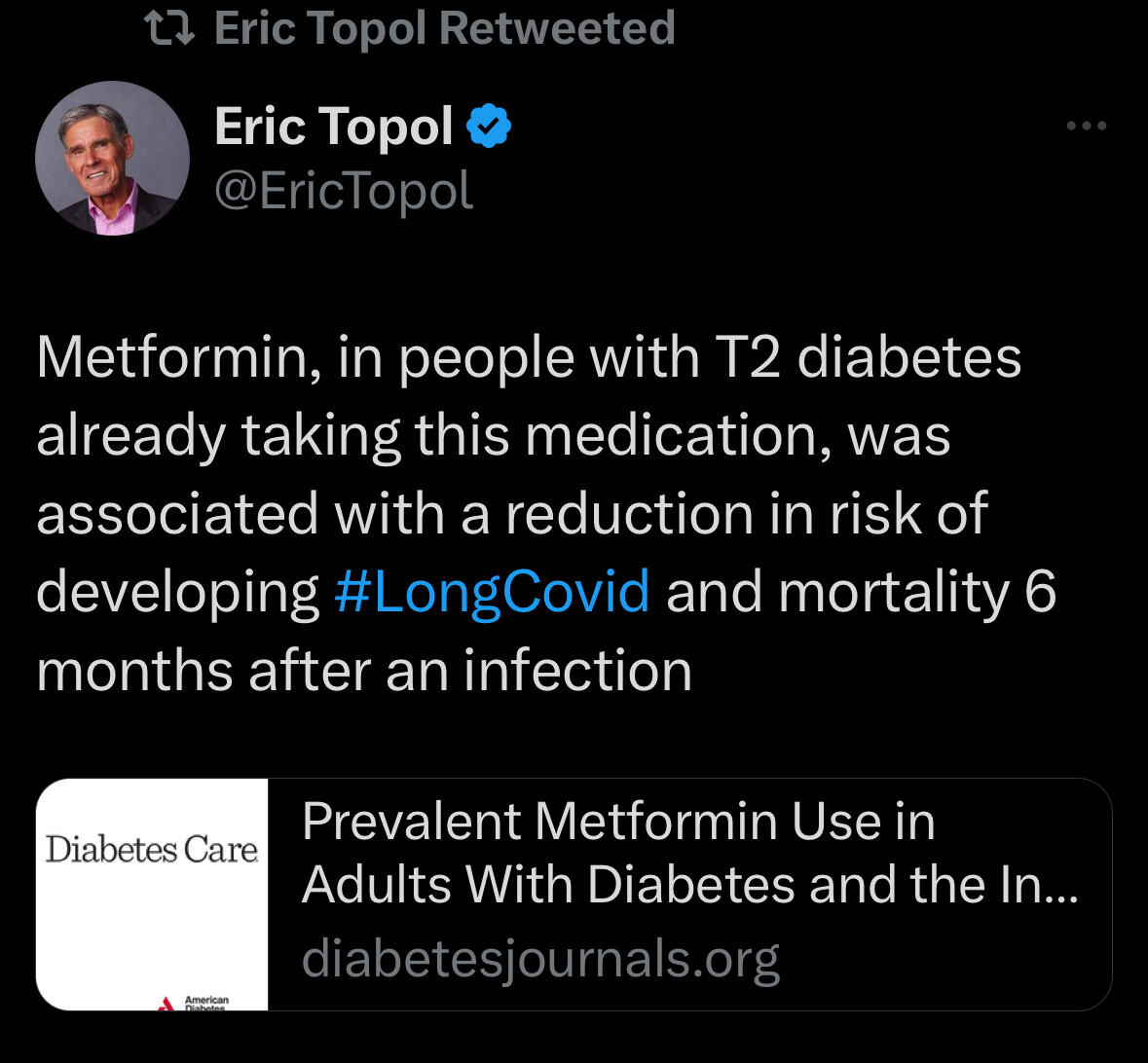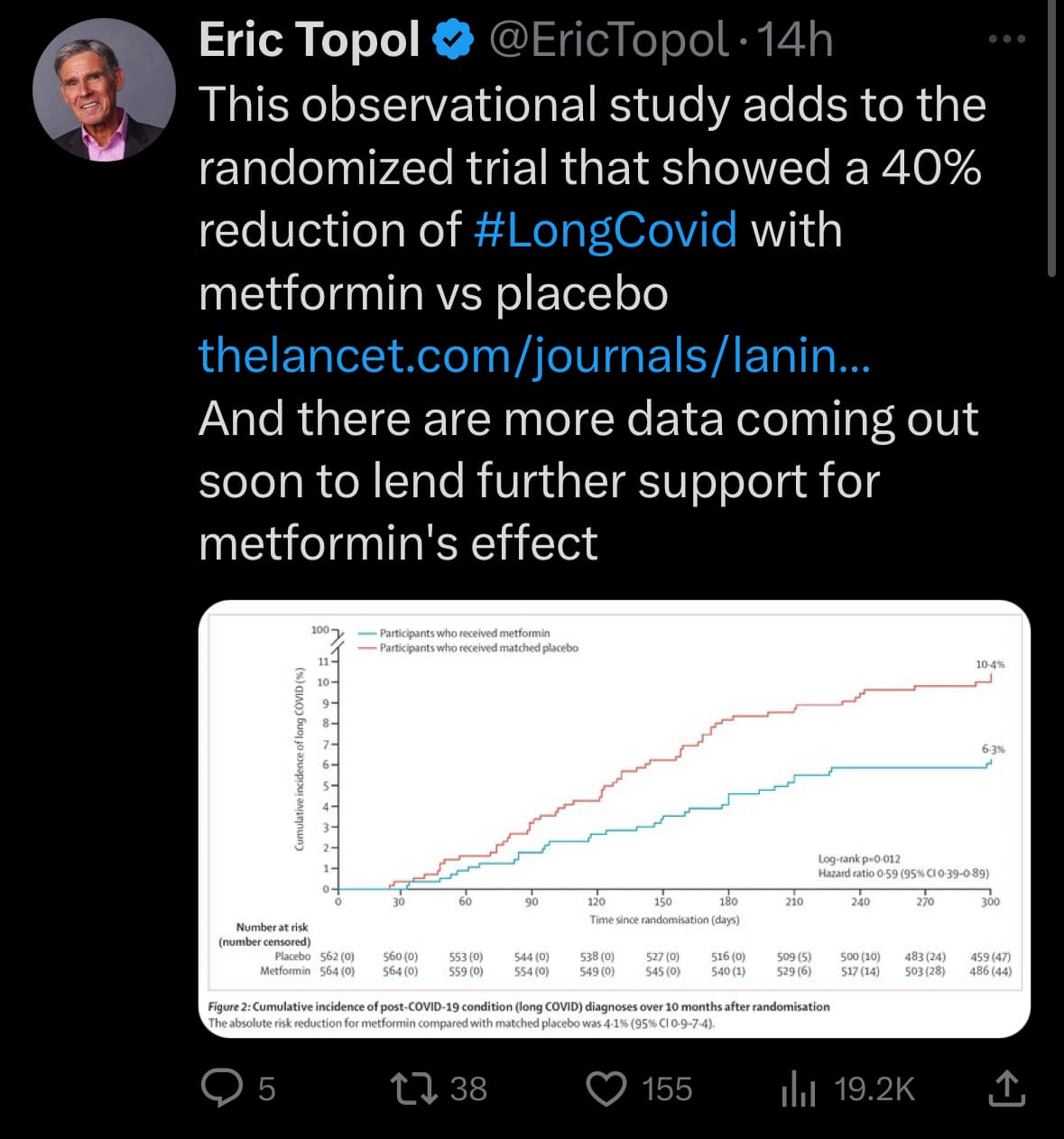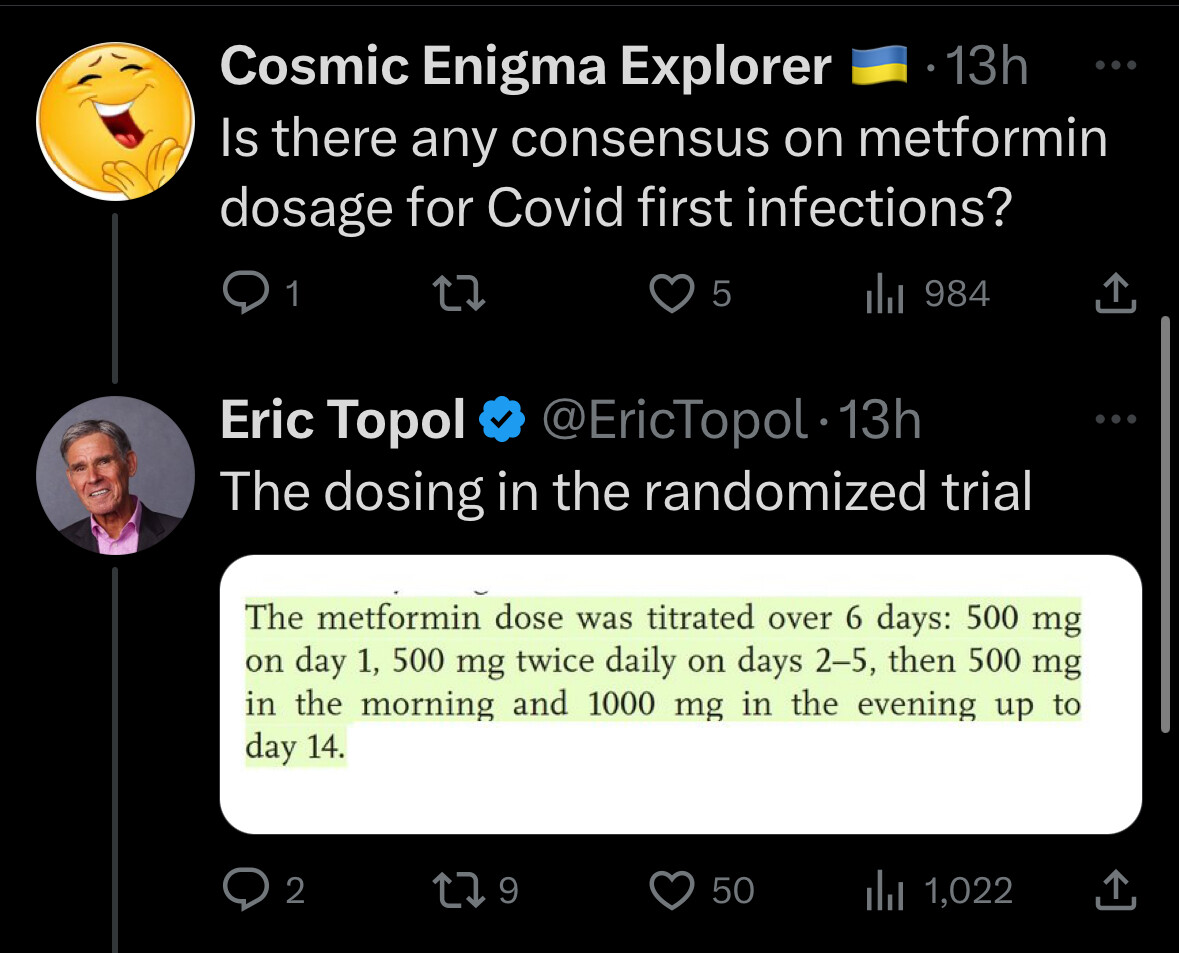Many human aging clocks have proved unreliable. So, I’m skeptical of a new aging clock for monkeys. Additionally, their metformin treatment group included only 6 monkeys.
You sure about that?
The Nature article about the paper says:
This led Guanghui Liu, a biologist who studies ageing at the Chinese Academy of Sciences in Beijing, and his colleagues to test the drug on 12 elderly male cynomolgus macaques (Macaca fasciucularis ); another 16 elderly monkeys and 18 young or middle-aged animals served as a control group.
Are there papers on other glucose-lowering drugs such as SGLT2, DPP4 or GLP-1RAs? Said otherwise: is the positive effect of metformin seen here only related to its glucose-lowering properties or is there something else?
Scattered through out the paper “Metformin decelerates aging clock in male monkeys” is “O-Met, n = 6”. The paper defines, “At the start of the study, monkeys were evenly divided by age and randomly assigned to either the metformin or vehicle treatment groups (hereafter referred to as O-Met and O-Ctrl).” So, yes, I’m sure the paper only treated 6 monkeys.
China is the world’s largest patent applicant, the world’s largest international patent applicant, the largest international journal publisher and citation country, and has surpassed the United States for ten consecutive years!
But, according to investigations, 50% of it is fraudulent. That’s compared to 10% in most other Western countries.
Thanks. So weird that the Nature story about the Cell paper for it so wrong! How on earth could such a good journal write the following when the N is actually 6:
This led Guanghui Liu, a biologist who studies ageing at the Chinese Academy of Sciences in Beijing, and his colleagues to test the drug on 12 elderly male cynomolgus macaques (Macaca fasciucularis ); another 16 elderly monkeys and 18 young or middle-aged animals served as a control group
Do you mind sharing the Cell paper btw, I was not able to access it and would love to read the real thing.
During the pandemic I believe nir barzilai discussed why he thought it would/was working - that might be one place to start (think is was more about other inflammatory and immune related pathways or something but was a few years ago so I’m not sure).
Haven’t read the more recent papers on Met and Covid but they may have different biomarker data and may also discuss their mechanistic understanding/conjectures.
They’re not wrong: they just wrote confusingly. Metformin was tested in 12 middle-aged monkeys (not elderly: here they’re echoing the paper’s incorrect description of the middle-aged monkeys as ‘old’). Six got Met; six were controls. The other animals of different ages were used for comparisons across age groups and for creating the biological age clocks.
I don’t have a well-informed opinion on this question beyond generally finding over several decades that I can trust reputable, refereed research conducted in China about as much as I can trust research conducted elsewhere. (An exception might be research with a political implication clear enough to come to the attention of the CCP.)
The US, of course, is no shining city on the hill in this regard. Research published with positive findings is material to promotion, reputation, compensation, and job security. Replication rates are appallingly low and outright fraud makes the news from time to time. More common is slanting study design or analyses, perhaps unconsciously at times, to obtain results favorable the the biases of the researcher. I see quite a bit of that in the US.
Are there objective studies showing the work of Chinese scientists to be less trustworthy than, for example, US -based research?
Why fake research is rampant in China: “Papers from China have the fourth-highest retraction rate in the world, according to Nature, a journal (see chart).”
The Chinese gov is aware of the problem: China conducts first nationwide review of retractions and research misconduct
Elite researchers in China say they had ‘no choice’ but to commit misconduct
There was another study where they looked at different papers and tried to replicate them or find issues and Chinese papers had a lower replication rate. I can’t find the article anymore. [EDIT: I think it was this one but I don’t have access anymore: Medicine is plagued by untrustworthy clinical trials. How many studies are faked or flawed?]
Thanks, I’ll take a look at this. I assume you found it credible.
Yes, I found it credible, and it’s aligned with my experience as a hobbyist reader of scientific papers: the average Chinese article I read is weaker than the average Western article. Most of the crap seems to come from Tier 2/3 Chinese university, though. When it’s Tsinghua, Beida, or Jiaotong, it tends to be better.
I think we better be careful in drawing comparisons. I have followed the US research over the past few decades because it aligns with work I do and it is not a pretty picture. We would need to index these data for research population statistics.
According to data from the Retraction Watch database, there have been over 39,000 retractions in US scientific research over the past decade, with the number of retractions increasing significantly each year; this data shows a rising trend in retractions within recent years.
Identifying Retracted Journal Articles | Duke University Medical Center Library Online.
The ‘publish or perish’ mentality is fuelling research paper retractions – and undermining science.
It looks to me like we are in the midst of a rising global phenomenon.
China represents 56% of fake publications, the US 7%: "Fake" Research Papers out of China, in Aging Field
There’s a lot of terrible research coming out of US institutions, but China is at another level. I’m sure the gov will crack down on that, and the problem will soon be solved.
Yes. Even though I might not prefer their tactics, my guess is that the rate of cheating of various kinds in mainland Chinese research will drop precipitously once the government makes it a priority whereas the US cheating is likely to continue to rise.
Still, with all of this acknowledged, many teams are international and very little research takes place devoid of a rich context well known to allied scientists across the world. It is likely that I and I assume others unconsciously pass over research that fails to meet some criterion (sometimes just a feel for the context) with the result being that we end up paying attention to decently conducted research. Of the thousands of papers I have read, even in the past decade, I can’t think of a study conducted solely in China that ended up as a distinctive empirical outlier to the crusted of associated and subsequent studies conducted in other nations. Disruptive scientific findings are rare (and are examined closely and critically because they are). Most studies are mind numbingly incremental and heavily bound to the context of the research of others around the globe. We will see soon enough whether this research on rhesus monkeys aligns with other research underway. If I had to guess, I think it will. Its weakness IMO, is the aging clock construct but that is a different discussion.
Senior Author is Concepcion Rodriquez Esteban affiliated with Altos Labs San Diego Institute of Science, San Diego, CA, USA
I don’t know this for certain but, from appearances, mainland China’s medical publications are worse than the US for status logrolling. I didn’t think that possible. In the short time I was teaching medical school, I saw the names of more first, second, and third authors go on research publications the nature of which they were scarcely aware. It was not uncommon for the lower ranked authors to be in faculty positions administratively subservient to the leading authors who expected their names not only to be on the publications but with top billing. Department heads who had rusty or little or no practical skills in research listed hundreds of publications on their CVs.
https://scholar.google.com/citations?user=-XyPrHcAAAAJ&hl=es
Concepcion Rodriguez Esteban
Senior Staff Researcher, Salk Institute for Biological Studies
Dirección de correo verificada de salk.edu - Página principal
EmbriogenesisAging and Regeneration
Below is another Chinese publication including Concepcion Rodriguez Esteban and Steve Horvath, Pedro Guillen Garcia from Madrid and Pradeep Reddy from Salk Institute as co-authors.
Yaobin Jing1,4,5,6,7,17 ∙ Xiaoyu Jiang1,4,5,6,17 ∙ Qianzhao Ji1,4,5,6 ∙ Zeming Wu1,4,5,6 ∙ Wei Wang1,4,5,6 ∙ Zunpeng Liu2,4,5,6 ∙ Pedro Guillen-Garcia11 ∙ Concepcion Rodriguez Esteban12,16 ∙ Pradeep Reddy12,16 ∙ Steve Horvath12,15 ∙ Jingyi Li1,4,5,6 ∙ Lingling Geng8,9 ∙ Qinchao Hu13,14 ∙ Si Wang8,9,10,18 ∙ Juan Carlos Izpisua Belmonte12,16,18 ∙ Jie Ren3,4,5,7 renjie@big.ac.cn ∙ Weiqi Zhang3,4,5,7 zhangwq@big.ac.cn ∙ Jing Qu2,4,5,6 qujing@ioz.ac.cn ∙ Guang-Hui Liu1,4,5,6,7,8,9,19


